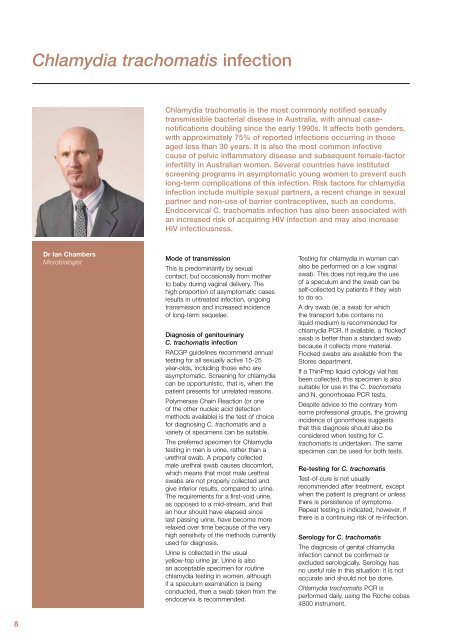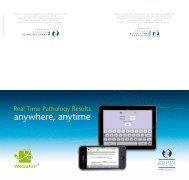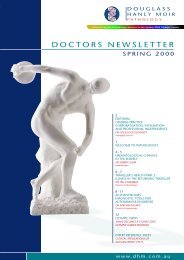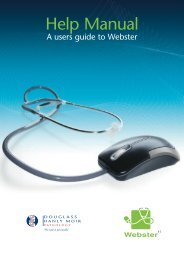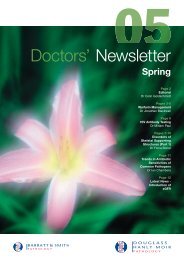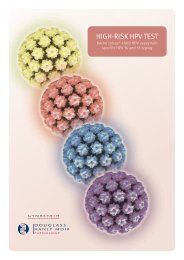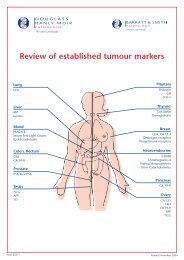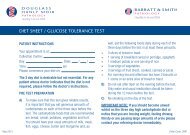Winter 2012 - Douglass Hanly Moir Pathology
Winter 2012 - Douglass Hanly Moir Pathology
Winter 2012 - Douglass Hanly Moir Pathology
- No tags were found...
You also want an ePaper? Increase the reach of your titles
YUMPU automatically turns print PDFs into web optimized ePapers that Google loves.
Chlamydia trachomatis infectionChlamydia trachomatis is the most commonly notified sexuallytransmissible bacterial disease in Australia, with annual casenotificationsdoubling since the early 1990s. It affects both genders,with approximately 75% of reported infections occurring in thoseaged less than 30 years. It is also the most common infectivecause of pelvic inflammatory disease and subsequent female-factorinfertility in Australian women. Several countries have institutedscreening programs in asymptomatic young women to prevent suchlong-term complications of this infection. Risk factors for chlamydiainfection include multiple sexual partners, a recent change in sexualpartner and non-use of barrier contraceptives, such as condoms.Endocervical C. trachomatis infection has also been associated withan increased risk of acquiring HIV infection and may also increaseHIV infectiousness.Dr Ian ChambersMicrobiologistMode of transmissionThis is predominantly by sexualcontact, but occasionally from motherto baby during vaginal delivery. Thehigh proportion of asymptomatic casesresults in untreated infection, ongoingtransmission and increased incidenceof long-term sequelae.Diagnosis of genitourinaryC. trachomatis infectionRACGP guidelines recommend annualtesting for all sexually active 15-25year-olds, including those who areasymptomatic. Screening for chlamydiacan be opportunistic, that is, when thepatient presents for unrelated reasons.Polymerase Chain Reaction (or oneof the other nucleic acid detectionmethods available) is the test of choicefor diagnosing C. trachomatis and avariety of specimens can be suitable.The preferred specimen for Chlamydiatesting in men is urine, rather than aurethral swab. A properly collectedmale urethral swab causes discomfort,which means that most male urethralswabs are not properly collected andgive inferior results, compared to urine.The requirements for a first-void urine,as opposed to a mid-stream, and thatan hour should have elapsed sincelast passing urine, have become morerelaxed over time because of the veryhigh sensitivity of the methods currentlyused for diagnosis.Urine is collected in the usualyellow-top urine jar. Urine is alsoan acceptable specimen for routinechlamydia testing in women, althoughif a speculum examination is beingconducted, then a swab taken from theendocervix is recommended.Testing for chlamydia in women canalso be performed on a low vaginalswab. This does not require the useof a speculum and the swab can beself-collected by patients if they wishto do so.A dry swab (ie, a swab for whichthe transport tube contains noliquid medium) is recommended forchlamydia PCR. If available, a ‘flocked’swab is better than a standard swabbecause it collects more material.Flocked swabs are available from theStores department.If a ThinPrep liquid cytology vial hasbeen collected, this specimen is alsosuitable for use in the C. trachomatisand N. gonorrhoeae PCR tests.Despite advice to the contrary fromsome professional groups, the growingincidence of gonorrhoea suggeststhat this diagnosis should also beconsidered when testing for C.trachomatis is undertaken. The samespecimen can be used for both tests.Re-testing for C. trachomatisTest-of-cure is not usuallyrecommended after treatment, exceptwhen the patient is pregnant or unlessthere is persistence of symptoms.Repeat testing is indicated, however, ifthere is a continuing risk of re-infection.Serology for C. trachomatisThe diagnosis of genital chlamydiainfection cannot be confirmed orexcluded serologically. Serology hasno useful role in this situation: it is notaccurate and should not be done.Chlamydia trachomatis PCR isperformed daily, using the Roche cobas4800 instrument.8


